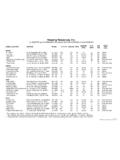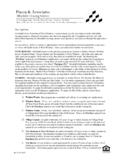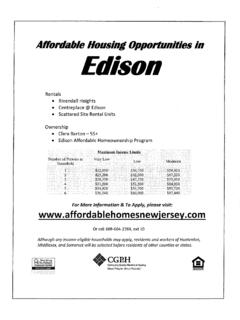Transcription of Letter from the Mayor - Welcome to NYC.gov
1 Table of Contents Executive Summary 5 Chapter 3: Building New affordable housing for All New Yorkers Introduction 14. 62 Enable a Wider Range of New Yorkers to Benefit from the City's affordable Chapter 1: Fostering Diverse, Livable housing Efforts Neighborhoods 64 Capitalize on Public Assets and 30 Pursue affordable housing and Partnerships to Maximize affordable Community Development Opportunities housing Opportunities in All Five Boroughs 69 Change Zoning and Land Use 34 Make Strategic Investments to Support Regulations to Promote housing Creation New housing and Neighborhood 72 Remove Unnecessary Barriers and Delays Revitalization to Developing housing 36 Promote Mixed-Used, Mixed-Income, 74 Ensure That housing Production Is Communities Anchored by affordable Sustainable and Aligned with the City's housing Changing Demographics 40 Create Quality Jobs and Workforce Development Opportunities for New Chapter 4: Promoting Homeless, Yorkers Senior, Supportive and Accessible housing Chapter 2.
2 Preserving the 78 Assist Homeless Individuals and Families Affordability and Quality of the Existing housing Stock 80 Expand Supportive housing 46 Ensure the Safety and Habitability of the 82 Improve housing Options for Seniors housing Stock 84 Ensure Accessible housing for 49 Adopt a More Strategic Approach to Individuals with Disabilities Preservation Chapter 5: Refining City Financing 50 Preserve Government-Assisted affordable housing Tools and Expanding Funding Sources for affordable housing 52 Preserve Rent-Regulated and Unregulated affordable housing 88 Target and Strengthen City Tax Incentives 53 Create New and Improved Preservation Tools 92 Identify New Funding Streams to Fund affordable housing 55 Promote Sustainability, Resiliency, and Long Term Affordability While Helping 92 Increase Private Leverage and Expand Building Owners Reduce Operating Costs Existing Financing Tools 94 Strengthen Public/Private and Philanthropic Partnerships 96 Re-Evaluate HPD and HDC Programs to Stretch City housing Subsidy Dollars Further Chapter 6: Implementing the Plan 104 Notes 106 Glossary 116 Acknowledgements Letter from the Mayor housing New York: A Five-Borough, Ten-Year Plan 2.
3 To My Fellow New Yorkers: We have a crisis of affordability on our hands. It's a crisis in many ways built on New York City's success. We are a safer, more welcoming city than we were decades ago. People from all over the world come to study, to work or to start a business here. And that success story has put pressure on our housing stock. Coupled with ever-rising economic inequality, it has created a painful reality where more and more New Yorkers are spending more and more to cover their housing costs, and entire neighborhoods have lost their affordability. affordable housing is part of the bedrock of what makes New York City work. It's what underpins the economically diverse neighborhoods New Yorkers want to live in. It's critical to providing financial stability for working families, helping them get ahead and build a better life. And that is why today, we are laying out a comprehensive plan to build and preserve 200,000 affordable units over the coming decade, to support New Yorkers with a range of incomes, from the very lowest to those in the middle class.
4 This is a plan to get ahead of the curve, to protect neighborhoods, and build our city's next generation of affordable housing . It's about knitting communities together. Our affordable housing policies must reach every New Yorker in need, which is why this plan thinks big about the changes we need to make in government and in the private sector to make this a city where everyone rises together, and everyone has a safe and decent home. If you're in a community where affordability is disappearing, we want to protect it. If your family lives in a rent-regulated apartment, this plan is focused on helping you keep it. If you're a senior trying to remain in the neighborhood you helped to build, we are fighting to help you stay. If you are a building owner or developer intent on building or preserving afford- able apartments, we will support you. This is a five-borough, ten-year plan. It will marshal people and resources from every corner of this city behind a singular purpose: to make this city again a place where our most vulnerable, our working people, and our middle class can all thrive.
5 Together, let's make that vision a reality. Mayor Bill de Blasio Executive Summary housing New York: A Five-Borough, Ten-Year Plan 4. Executive Summary affordable housing for Every New Yorker Every New Yorker deserves a safe and affordable place to live, in a neighborhood that provides opportunities to get ahead. The market alone is not always able to meet that need, and, accordingly, governments at all levels must work together to help. Mayor Bill de Blasio has made affordable housing a top priority of his admin- istration and has committed the City to build or preserve nearly 200,000 afford- able units, and help both tenants and small landlords preserve the quality and affordability of their homes.. Facts about the New York City's shortage of affordable housing has reached a crisis point. The Affordability Crisis crisis has many causes, starting with the erosion of New Yorkers' purchasing Between 2005 and 2012, power in the housing marketplace.
6 Wages for the City's renters have stagnated rents rose by 11 percent over the last 20 years, increasing by less than 15 percent, after adjusting for infla- while renter's incomes tion. During the same period, the average monthly rent for an apartment in New stagnated, after adjusting York City increased by almost 40 percent. As a result, most New Yorkers now have for inflation limited options for housing and have to spend an unacceptably high share of their In 2012, almost 55 percent income just to put a roof over their heads, which means having too little left over of all rental households were for other basic needs. High rent-burden affects nearly every income group in every rent-burdened (spending neighborhood across the five boroughs. more than 30 percent of their incomes on housing costs). Another cause of the affordable housing crisis is the mismatch between demand The share of households for, and the supply of, housing .
7 This stems, in part, from the increasing desirability who are rent-burdened of calling New York home. For the first time in decades, more people are moving to increased by more than 11 or staying in the City than leaving: our older residents are aging in place rather percentage points since than moving after retirement; our young families are remaining in the City rather 2000. than moving to the suburbs when their children reach school age; empty-nesters More than 30 percent of are returning to the City after their children are grown, and people are moving to rental households are the City from all over the United States, as well as all over the world. The attrac- severely rent-burdened tiveness of the City is a hard-fought victory, and we must continue to retain and because they spend more attract residents in order to prosper. than 50 percent of their incomes on housing The private marketplace, however, has not produced enough housing for existing residents, let alone enough to accommodate the growth that the City has experi- enced.
8 And, despite considerable public investment to stimulate the production of housing that is affordable to low- and moderate-income New Yorkers, the supply of publicly subsidized housing meets the needs of only a fraction of the people in those income groups. The continued mismatch between the demand for affordable housing and its supply also exacerbates the rising income inequality that threatens the City's progress. When more than 50,000 New Yorkers sleep in homeless shelters and hundreds of thousands more struggle to pay high rents with meager earnings, the City fails to live up to its promise of opportunity. housing New York: A Five-Borough, Ten-Year Plan 5. Supply Is Not Meeting Things must change. A bold approach to increasing and protecting the supply of Demand affordable housing is needed for New York City to retain the diversity and vitality There are nearly one million of its neighborhoods and its edge as the world's leading destination for opportuni- households who earn ty.
9 And it is needed to house the incredible and multidimensional talent pool that less than 50 percent of attracts employers and drives the City's economic growth. Area Median Income (AMI), or just under $42,000 for housing New York is a five-borough, ten-year strategy to address the City's afford- a family of four able housing crisis. The plan, which was created through coordination with 13. There are only 425,000. agencies and with input from over 200 individual stakeholders, outlines more than housing units available 50 initiatives to support our goal of building or preserving 200,000 units of with rents suitable for that high-quality affordable housing to meet the needs or more than 500,000 people. income level We will do this by: Fostering diverse, livable neighborhoods Preserving the affordability and quality of the existing housing stock Building new affordable housing for all New Yorkers Promoting homeless, senior, supportive and accessible housing Refining City financing tools and expanding funding sources for affordable housing What is affordable housing ?
10 Monthly Rent Required to Annual Income (for a Income Band Percentage of AMI. Prevent Rent-Burden four-person household). Extremely Low Income 0- 30% Up to $629 < $25,150. Very Low Income 31 - 50% $630 - $1,049 $25,151 -$41,950. Low Income 51 - 80% $1,050 -$1,678 $41,951 - $67,120. Moderate Income 81 - 120% $1,679 - $2,517 $67,121 - $100,680. Middle Income 121 -165% $2,518 - $3,461 $100,681 - $138,435. housing New York: A Five-Borough, Ten-Year Plan 6. Guiding Principles 1. Our housing policies must address the 5. We must strategically protect past City's changing demographics and investments and lock in affordability in expand the range of those we serve. changing neighborhoods. We must We must recognize the unique needs of ensure that billions of dollars already invested growing populations of small households and in subsidized affordable housing are not lost seniors, as well as those of larger families.















